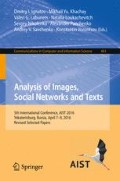Abstract
In this paper the novel fast approach to identify the reflection symmetry axis of binary images is proposed. We propose to divide a skeleton of a shape into two parts – the “left” and the “right” sub-skeletons. The left part is traversed counterclockwise and the right one – in clockwise direction. As a result, the “left” and the “right” primitive sub-chains are achieved; they can be compared by the known shape matching procedure based on pair-wise alignment of primitive chains. So, the most similar parts of a skeleton among all possible ones correspond to the most similar parts of a figure which are considered as reflection symmetric parts. The start and the end points of skeleton division into “left” and “right” parts will be the points belonging to a symmetry axis of a figure. Also, the exact brute-force symmetry evaluation algorithm and two its optimizations are suggested for finding ground truth of symmetry axis. All proposed methods were experimentally tested on Flavia leaves dataset.
Access this chapter
Tax calculation will be finalised at checkout
Purchases are for personal use only
References
Arkin, E.M., Chew, L.P., Huttenlocher, D.P., Kedem, K., Mitchell, J.S.B.: An efficiently computable metric for comparing polygonal shapes. IEEE Trans. Pattern Anal. Mach. Intell. 13, 209–216 (1991)
Blum, H.: A transformation for extracting new descriptors of shape. Models Percept. Speech Vis. Form 19(5), 362–380 (1967)
Kushnir, O., Seredin, O.: Parametric description of skeleton radial function by legendre polynomials for binary images comparison. In: Elmoataz, A., Lezoray, O., Nouboud, F., Mammass, D. (eds.) ICISP 2014. LNCS, vol. 8509, pp. 520–530. Springer, Heidelberg (2014). doi:10.1007/978-3-319-07998-1_60
Kushnir, O., Seredin, O.: Shape matching based on skeletonization and alignment of primitive chains. In: Khachay, M.Y., Konstantinova, N., Panchenko, A., Ignatov, D.I., Labunets, V.G. (eds.) AIST 2015. CCIS, vol. 542, pp. 123–136. Springer, Heidelberg (2015). doi:10.1007/978-3-319-26123-2_12
Latecki, L.J., Lakämper, R.: Convexity rule for shape decomposition based on discrete contour evolution. Comput. Vis. Image Underst. 73(3), 441–454 (1999)
Ling, H., Jacobs, D.W.: Shape classification using inner-distance. IEEE Trans. PAMI 29, 286–299 (2007)
Liu, J., et al.: Symmetry detection from realworld images competition: summary and results. In: 2013 IEEE Conference on Computer Vision and Pattern Recognition Workshops (CVPRW), pp. 200–205 (2013)
Sheynin, S., Tuzikov, A., Volgin, D.: Computation of symmetry measures for polygonal shapes. In: Solina, F., Leonardis, A. (eds.) CAIP 1999. LNCS, vol. 1689, pp. 183–190. Springer, Heidelberg (1999). doi:10.1007/3-540-48375-6_23
van Otterloo, P.J.: A contour-oriented approach to digital shape analysis. Ph.D. thesis, Delft University of Technology, Delft, The Netherlands (1988)
Wu, S.G., Bao, F.S., Xu, E.Y., Wang, Y.-X., Chang, Y.-F., Xiang, Q.-L.: A leaf recognition algorithm for plant classification using probabilistic neural network. In: 2007 IEEE International Symposium on Signal Processing and Information Technology, pp. 11–16 (2007)
Yang, X., Adluru, N., Latecki, L.J., Bai, X., Pizlo, Z.: Symmetry of shapes via self-similarity. In: Bebis, G., Boyle, R., Parvin, B., Koracin, D., Remagnino, P., Porikli, F., Peters, J., Klosowski, J., Arns, L., Chun, Y.K., Rhyne, T.-M., Monroe, L. (eds.) ISVC 2008. LNCS, vol. 5359, pp. 561–570. Springer, Heidelberg (2008). doi:10.1007/978-3-540-89646-3_55
Acknowledgements
This work is partially supported by Russian Fund for Basic Research, Grants 14-07-00527 and 16-57-52042.
Author information
Authors and Affiliations
Corresponding author
Editor information
Editors and Affiliations
Rights and permissions
Copyright information
© 2017 Springer International Publishing AG
About this paper
Cite this paper
Kushnir, O., Fedotova, S., Seredin, O., Karkishchenko, A. (2017). Reflection Symmetry of Shapes Based on Skeleton Primitive Chains. In: Ignatov, D., et al. Analysis of Images, Social Networks and Texts. AIST 2016. Communications in Computer and Information Science, vol 661. Springer, Cham. https://doi.org/10.1007/978-3-319-52920-2_27
Download citation
DOI: https://doi.org/10.1007/978-3-319-52920-2_27
Published:
Publisher Name: Springer, Cham
Print ISBN: 978-3-319-52919-6
Online ISBN: 978-3-319-52920-2
eBook Packages: Computer ScienceComputer Science (R0)

